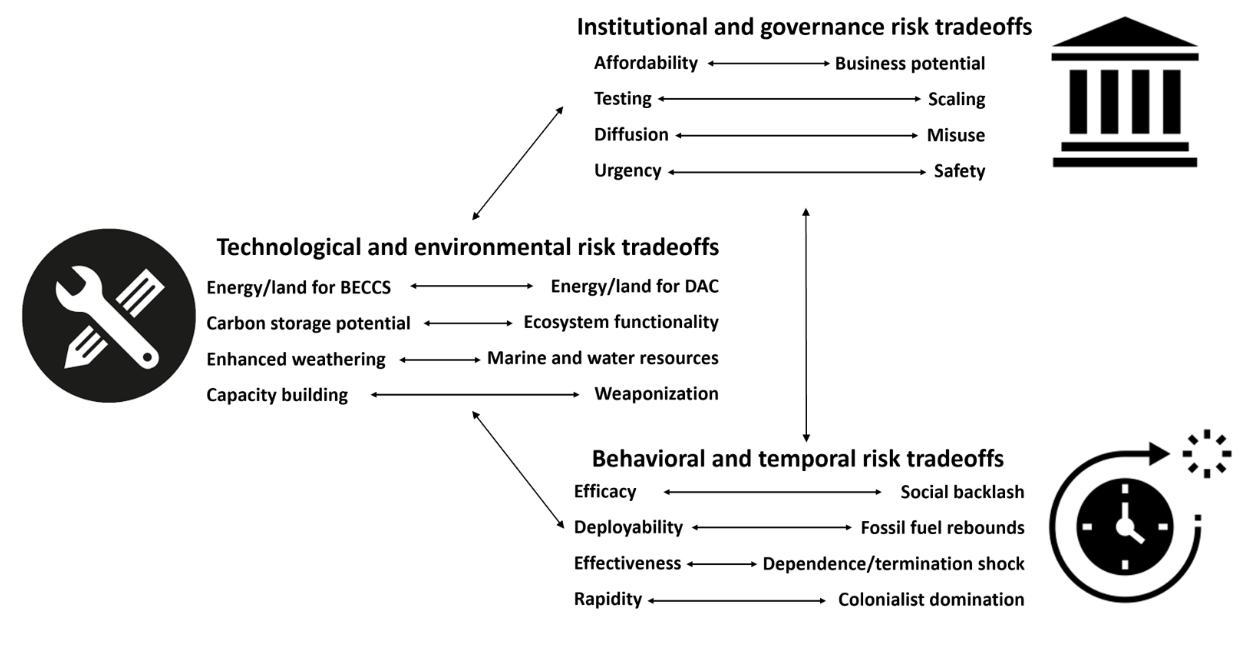The multiplication of risk in carbon removal pathways

[The views of guest post authors are their own and do not necessarily reflect any official positions of the authors’ organisations or C2G. We encourage a constructive conversation involving multiple viewpoints and voices]
Increasingly tense and fraught discussions are underway to utilize emerging technological options to help address climate change and stabilize the climatic system. For instance, direct air capture with carbon storage utilizes very large fans to remove carbon dioxide directly from the air. Bioenergy with carbon capture and storage (BECCS) emphasizes growing and harvesting plants as a source of energy and thus carbon storage. Enhanced weathering works by increasing the ability of rocks to absorb carbon dioxide from the atmosphere. Biochar removes carbon by converting organic material, whether from plants or animals, into a form of charcoal.
Based on a large sample of expert interviews undertaken for the GENIE project, a consensus seems to be emerging that risks abound no matter which emergent options scientists, policymakers, or national publics support and undertake. As one of our expert respondents put it:
Energy system transition is like a game of poker. We won’t know which technology will work, we don’t have good predictive skill for technologies like solar that are already a decade ahead. Think back: for technologies in the 1950s, how much predictive skill did we really have for 2050? Imagine how actors then would have distributed their bets. It’s a monumental challenge.
Another explained that:
There are huge investment risks with deploying climate engineering: where to put the money, where to put the finance, where to create markets. There are risks everywhere. It comes down to how you talk about technology transitions, deal with futures, anticipate problems and integrate them into policy development.
Our systematic analysis of these interview data revealed no less than 12 different baskets of risk, which we have termed “risk-risk” tradeoffs to underscore that climate action does not eliminate risk. Any attempt to address a risk in one area only unleashes another type of risk in another dimension. Moreover, these risk-risk tradeoffs cut across different dimensions including institutions and governance, technology and the environment, and behavior and future generations.
Institutional, technological, and behavioral tradeoffs in climate engineering deployment

For instance, in the institutional and governance dimension, the more affordable climate-geoengineering technologies become, the more they are likely to be used, but at the same time, the cheaper they are, the less value there is for firms to capture, or motivation for incumbent firms to enter the market. Moreover, current experiments are usually piloted and implemented at very small scales to minimize risk—making them safer for the environment—but this also makes it more difficult to scale up such experiments or to predict impacts at larger scales. Small-scale experiments would have no measurable effect on the climate or atmosphere, but large experiments extending up to many kilometers in altitude or over vast areas of land would of course pose greater risks but also increase scientific understanding considerably.
In the technological and environmental dimension, both bioenergy with carbon capture and storage and direct air capture hold great promise for climate protection, but the insufficient availability of land and constraints on energy use may force hard choices between them. Moreover, enhanced weathering deployment could rely on massive mining operations that would generate multiple stresses on water availability and quality. Nature-based approaches to carbon removal could rely on large amounts of land or fertilizer, degrading ecosystems and habitats, or could also see the replacement of native species with genetically engineered ones, with deleterious affects on local forests.
Finally, on the behavioral and temporal dimension, the more both carbon dioxide removal (CDR) is successfully deployed, the more they could be perceived to reduce climate change, and thus the more some social actors may respond by increasing the use of fossil fuels or arguing that there are legitimate needs for further growth in fossil-fuel consumption. This is especially the case with engineered options for carbon removal and storage, which could be coupled to enhanced oil recovery. This critique thus applies to direct air capture and bioenergy with carbon capture and storage. Furthermore, urgent deployment done in response to “climate emergency” can germinate fears of colonialism and technological domination between countries. As one of our experts explained:
There is potential for some of these techniques – and I’m thinking particularly here, of CDR techniques – to operate in parts of the world which are generally less economically developed. So there is potential for use of large land areas, sparsely populated, which often correlates with a low development index. So there could be benefits there that pass, economically. But there’s also risk of the resource curse, where money flows to the elites in those societies, or corruption where benefits aren’t actually what they’re thought to be, because of poor governance. Then there’s also a kind of almost colonialism, where more developed economies basically say, “Well, we don’t want to do the hard work ourselves, so we’ll shift it onto other people,” who are less economically advanced.
Then there’s also a kind of almost colonialism, where more developed economies basically say, “Well, we don’t want to do the hard work ourselves, so we’ll shift it onto other people,” who are less economically advanced.
This latter form of colonialism would even be perceived by those doing it as benevolent, on behalf of countries in the Global South who don’t have the capacity or resources to do so—a tradeoff that could also accelerate some of the other risk-risk tradeoffs.
In sum, these pernicious 12 types of risk-risk tradeoffs suggest that deployment of any single option will necessitate adaptive risk management, as risks and tradeoffs intersect within and across our three dimensions of institutions and governance, technology and the environment, and behavior and temporality. Positively, there is also the potential for mitigating risks in some dimensions to help alleviate risks in others, that is, if more progressive and adaptive risk management is undertaken.
Given the scale and scope of risk-risk tradeoffs, one cannot just “add up” the mitigation or carbon storage potential for the various options examined here, as they invariably compete for land, energy, water, capacity, policy attention, experimental governance, and other resources – and, what is more, introduce risks that can ultimately undermine institutional stability, technological performance, and social behavior.
Our findings soberingly challenges those arguments in favor of a “portfolio approach” or “cocktail approach” whereby as many potential negative-emissions and solar-geoengineering options as possible are bundled together at once. A portfolio approach, if done poorly, risks endorsing a bundle of technologies randomly jumbled together rather than any coherent vision. If each specific option involves different dimensions of risks and incompatibilities, supporting some or addressing one set of risks threatens to erode another or unleash a new set of risks. Risks are never wholly eliminated, managed, or reduced, only shifted across time or redistributed across different actors.
Dr Benjamin K. Sovacool is Professor of Energy Policy at the Science Policy Research Unit (SPRU) at the University of Sussex Business School in the United Kingdom. He is also Professor of Earth and Environment, Boston University and University Distinguished Professor of Business and Social Science, Aarhus University.
Further reading
“Climate policy for a net-zero future: ten recommendations for Direct Air Capture:” published in Environmental Research Letter
“Risk–risk governance in a low-carbon future:” published in Risk Analysis